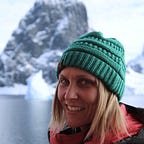Iceland Day 6
This morning, we revisited Jokulsarlon and the experience drastically contrasted yesterday’s adventure. The harsh wind was no longer present, the sun shone and the magic of the glacial icebergs took on new behaviors, shapes, and characteristics.
I spent time following the path that the glacial icebergs take from the lagoon, through a narrow inlet and into open ocean where they zigzag with the waves prior to landing on the beach. All the while, allowing currents, tides, and waves to guide their own expeditions. In addition to the motion of the water, the temperature, wind, and sand all play a role in how the icebergs morph along the way. I watched as they broke free from the lagoon and were swiftly navigated through the inlet, sometimes being accompanied by seals, ducks, and other sea birds as temporary companions on the journey, I observed some chunks become entangled in shallow water, thrust upon the banks and eventually freed to continue their journey to the ocean. I could not help but personify the icebergs, imagining their conversations, their greetings, salutations, thoughts, and emotions as they all journey through this experience at different rates, times, and with contrasting experiences along the way. Isn’t that just like us? This show of nature was a huge metaphor for our own lives, experiences, changes we encounter and differing perspectives along the way. Not one single iceberg has the same experience, but each have the same ending fate — washing ashore on Diamond Beach. Human observers only catch a glimpse of each icebergs “life” even if followed from lagoon to black sand beach — we can’t possibly see the entire transformation from water droplet rising in the atmosphere, condensing as a member of a cloud formation, eventually precipitated to the each, frozen within a glacier, melting, moving, breaking off into the lagoon and so on. Even the icebergs I watched and followed for their entire “visible” journey had so much more to their own narratives than I could possible imagine. Even if we as humans, know another human being so intimately that we are there for all of their lifespan, we can and could not possibly see everything, know everything, understand everything within another human beings’ experience. It just isn’t possible. Yes, all of this sparking from a single moment in time, an observation of glacial icebergs in Iceland.
For lunchtime, we journeyed to a second glacial lagoon, Fjallsarlon. This lagoon is enclosed, so the water from the melting glacier and its icebergs within the lagoon filter into ground water rather than out to the ocean. The sun beat down and caused me to shed a few of my layers, it felt closer to a typical summer on the east coast of Virginia, where I am from. The air temperature never even reached 70 degrees Fahrenheit, but compared to the previous days, this felt like 90 degrees. As I traveled along the edge of this lagoon, light winds occasionally blew, cooling me off and it hit me; this is nature’s air conditioning. I am next to a lagoon filled with glacial melt and icebergs, as the wind blows across the lagoon, it is cooled by the ice within and therefore provides a reprieve from the heat — air conditioning. Within buildings, homes, and automobiles, this is achieved through mechanical replication of these naturally occurring processes.
Fascinating.
Our next stop was Reynisfjara, the famous black sand beach with “sneaker waves” and iconic hexagonal basalt columns. The day had taken a lot out of me mentally and physically, I took these moments to relax, speak to the basalt, and sit on the black sand beach.
Yes, you read that correctly, I spoke to the basalt. The earth is a living being, even nonliving pieces of our earth are worth conversing with. They can still teach you many things, make you wonder, make you come closer, and beg for your attention. These columns are fascinating indeed.
Columnar basalt varies greatly from the black formations traditionally and easily recognized as basalt. Columnal basalt is formed when different points within the rock begin to cool at different rates, the geometric pattern then emerges. In this case it is hexagonal and the cooling then shoots vertically creating columns of basalt, rather than traditional flowing lava that cools and hardens and creates a more pudding like looking rock formation that we traditionally connect as basalt rock. Around 90% of all lava rock on earth is basalt, and usually appears to be black and porous, sometimes showing itself in roping patterns; ripple like. All of these formations and characteristics are determined by the rate of cooling and location. For example, roping commonly forms when lava comes into contact with water. Igneous rock (formed from lava or magma cooling and hardening) is a fascinating group of rocks due to its connection to volcanoes and geothermal activity; again lending itself to another great metaphor about diversity, perspective, and varied experiences. So much to unpack, I know this will permeate my own reflections for quite some time.
Tonight we stay at a campsite in Vik, tomorrow we visit Skogafoss, another magical Icelandic waterfall, I am certain!
